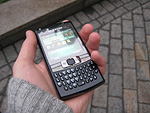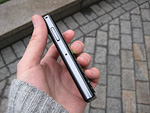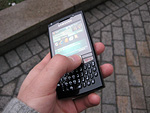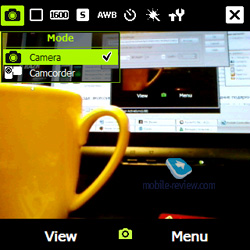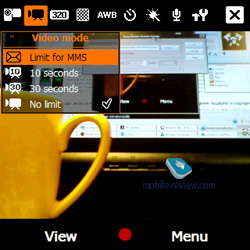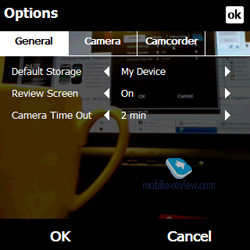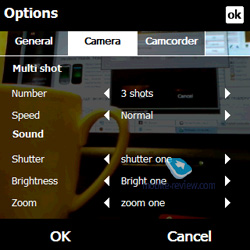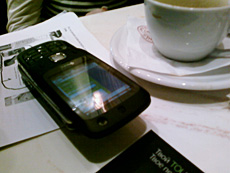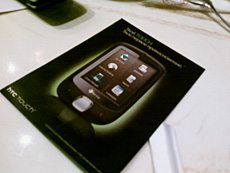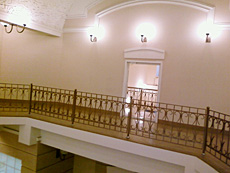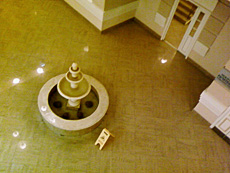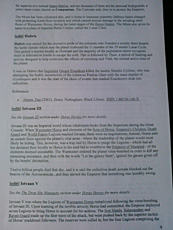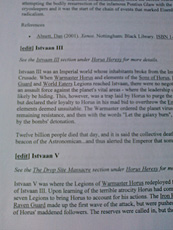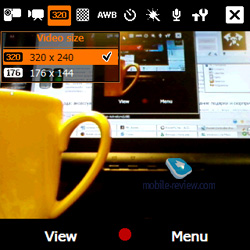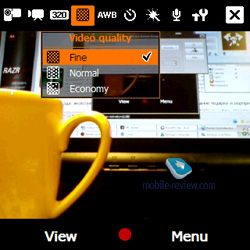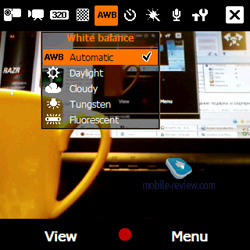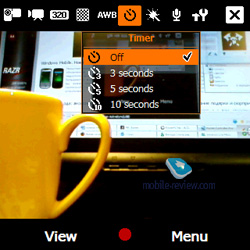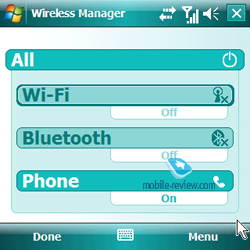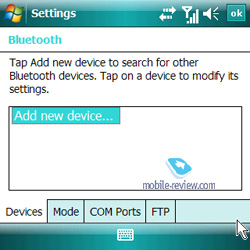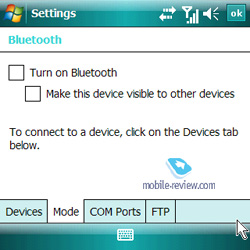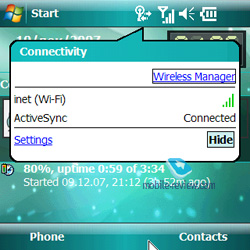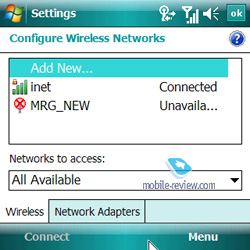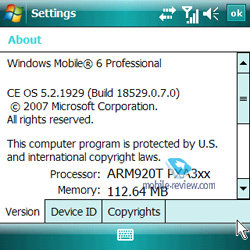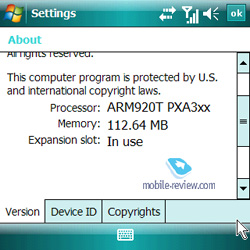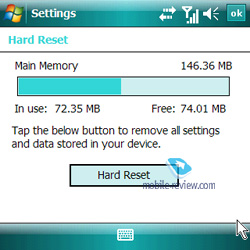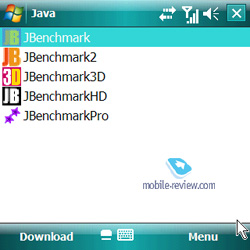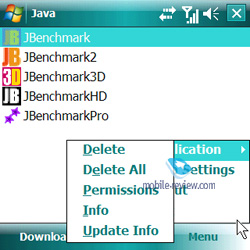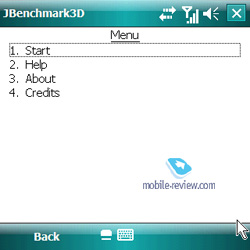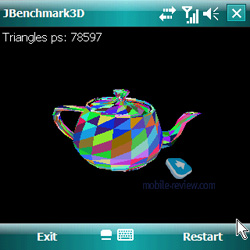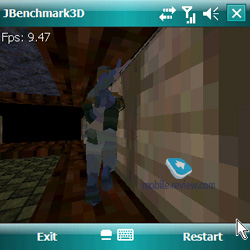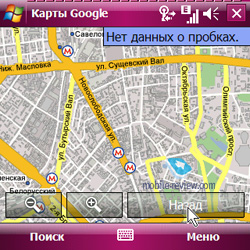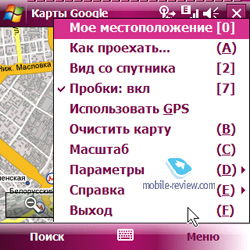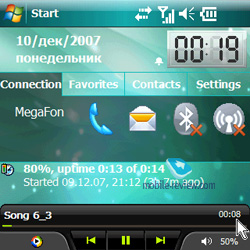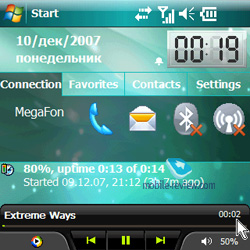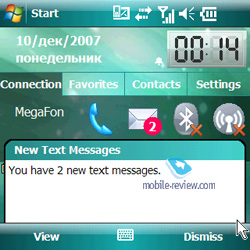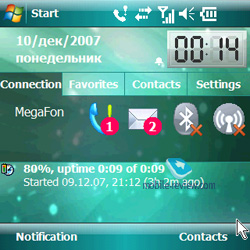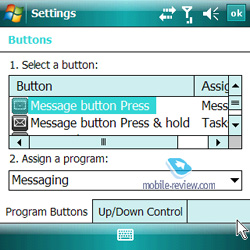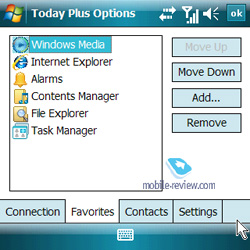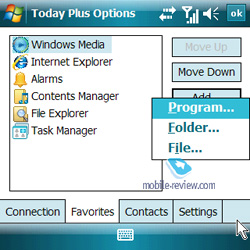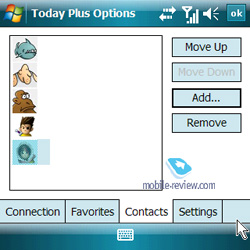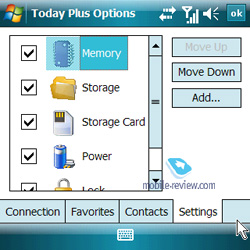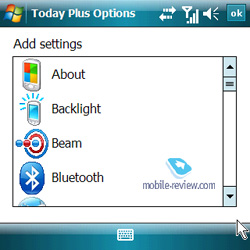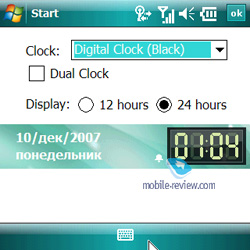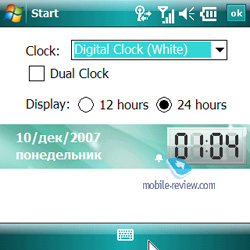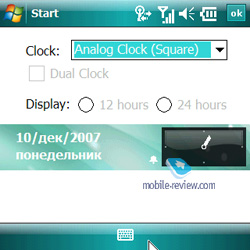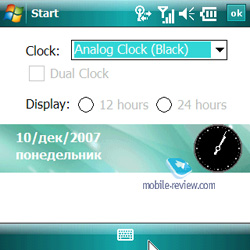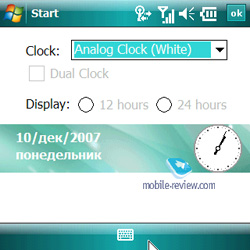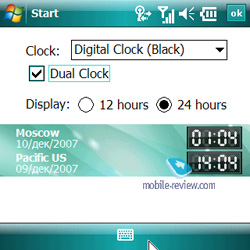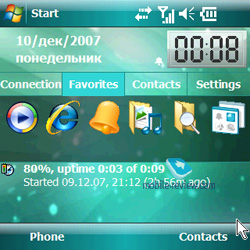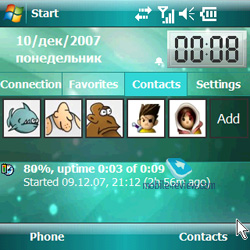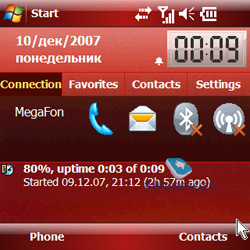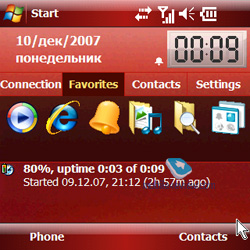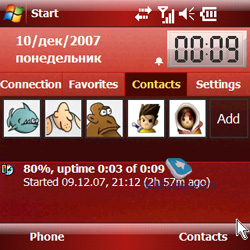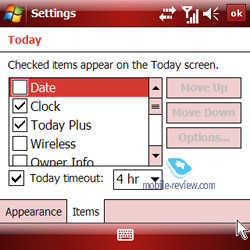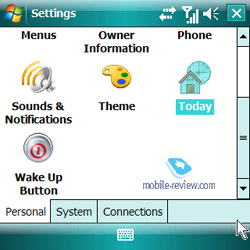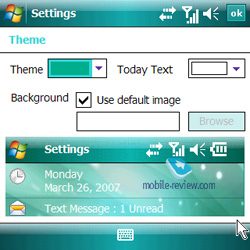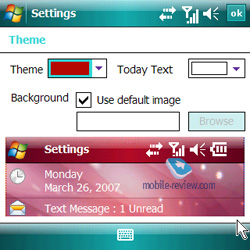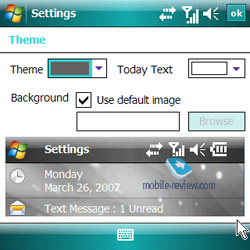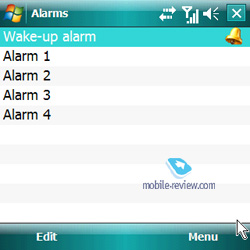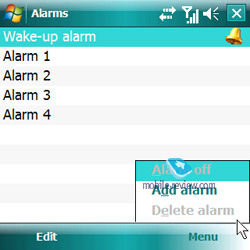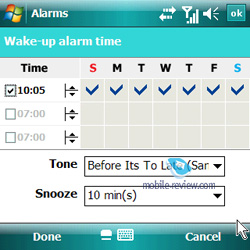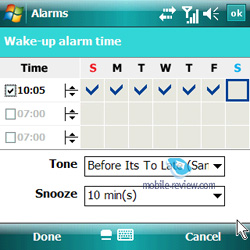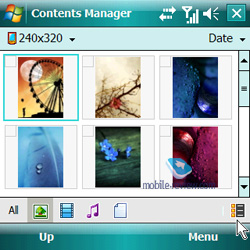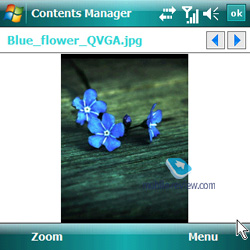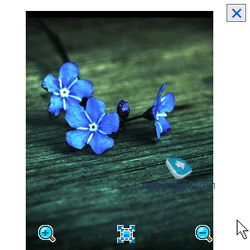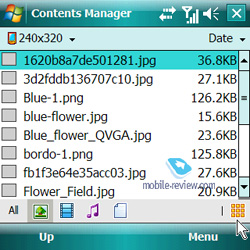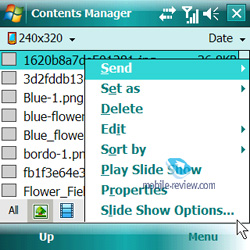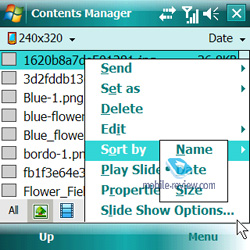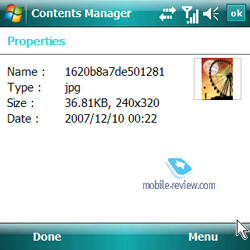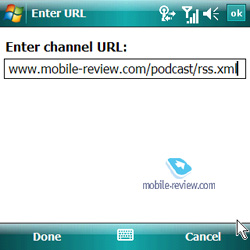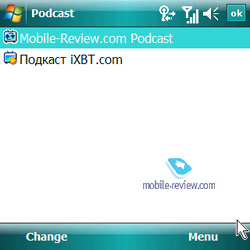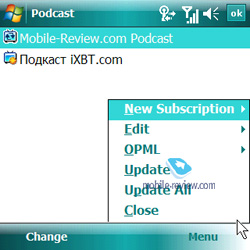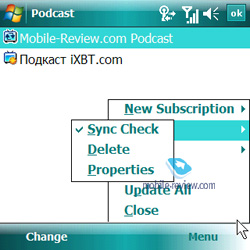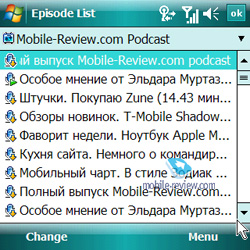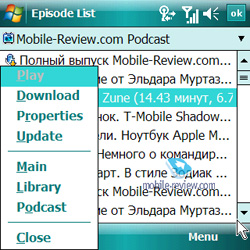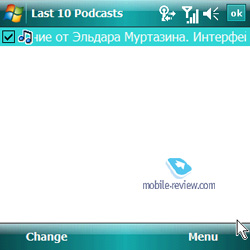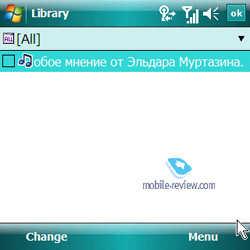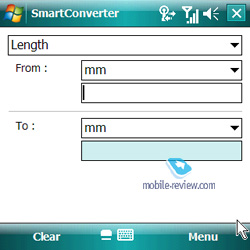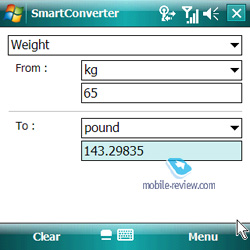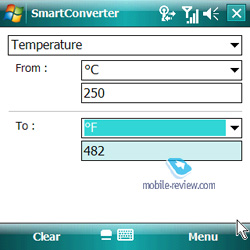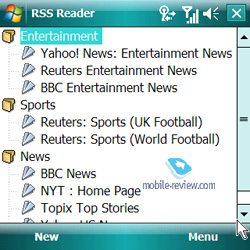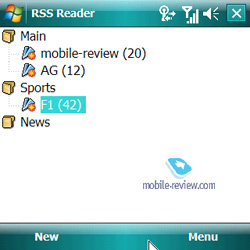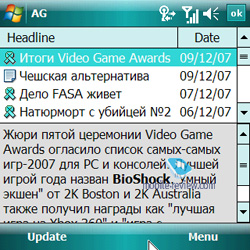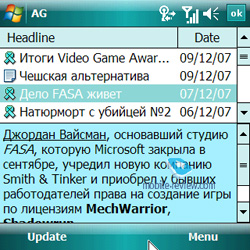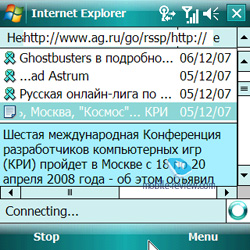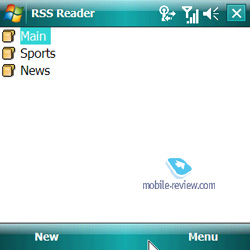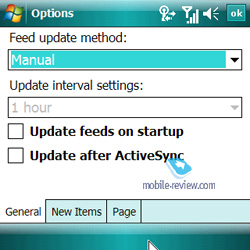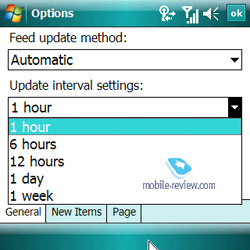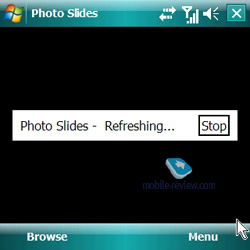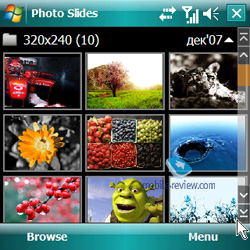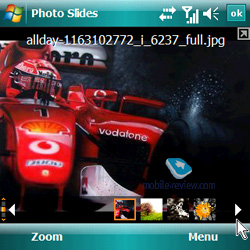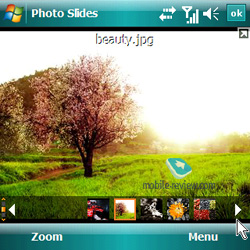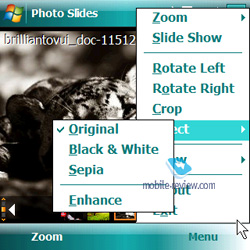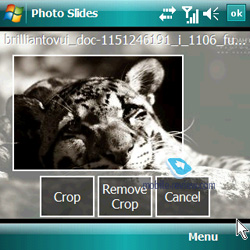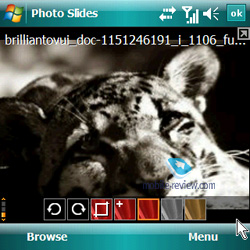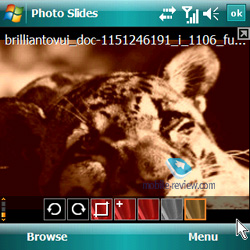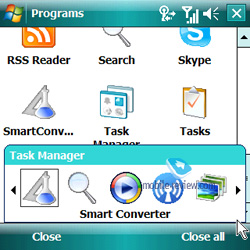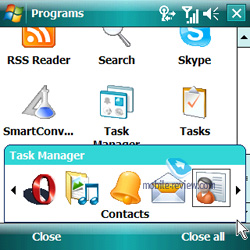|
|
Review of UMTS-communicator Samsung i780
Part two – hardware platform, navigation, preinstalled software
Live photos of Samsung i780
Table of contents:
- Camera
- Connectivity
- Hardware platform
- Performance
- Navigation (GPS)
- Multimedia
- Software
- Impressions
Sales package (expected):
- Communicator
- Data cable
- Charger
- Wired stereo-headset
- Software CD
- User Guide
The first part of the review takes a gander at the i780’s design, ergonomics and controls, and this installment focuses on what it packs under the hood. But we are going to start the things off with the Samsung i780’s camera.

Camera
The communicator comes installed with a 2 Mpix camera (CMOS) with fixed focus, no self-portrait mirror or flash. The camera is housed on the bulge on the rear of the casing. But before you get to shooting, make sure you have rubbed the camera lens clean - it is a real grease-magnet.

When we got our hands on the i780, we had some high hopes that this communicator would be in line with the company's other offerings in terms of imaging. It is logical to suppose that the camera has to be somewhere along the lines of the display, found in the Samsung i780, which is one of the finest units available in the Windows Mobile market, even though it breaks no new ground as far as Samsung-branded devices are concerned. Since the maker's feature phones and smartphones sport pretty potent cameras, we thought that the i780 had to ship with something decent onboard as well.
Getting ahead of ourselves, the communicator’s camera unit snaps typical photos, sadly, not for a Samsung's device, but for a Windows Mobile offering.
The camera is activated by pressing and holding the side-mounted button (on the right). In the system’s settings, however, you can reassign the camera application to any other available button.
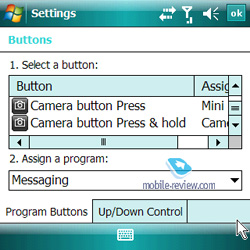
The interface is by far the best thing about the i780’s camera – it is very complete and easy to use. While in the viewfinder mode, you will be presented will all major settings, and every icon there is pretty much self-explanatory.
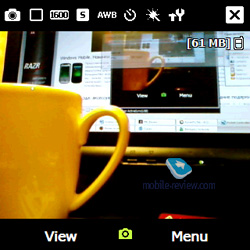
To adjust the camera's settings, you just need to press the right soft-button, then pick required options appearing in pop-up windows. While in the still image mode, menu items will be highlighted in green, and for video mode the i780 will use red. This doesn't seem like much, but thanks to this feature you will be able to quickly figure out which mode is currently active.
Below is a rundown on the Samsung i780 camera’s settings and options:
The following resolutions are available:
- 1600x1200 pixels
- 1280x960 pixels
- 1024x768 pixels
- 640x480 pixels
- 320x240 pixels
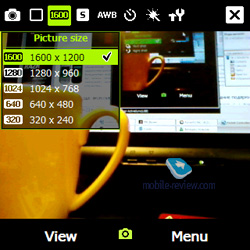
Image quality:
- Economy
- Normal
- Fine
- Super fine
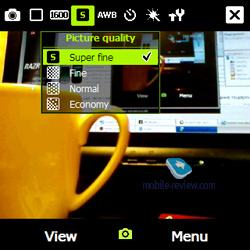
White balance:
- Automatic
- Daylight
- Cloudy
- Tungsten
- Fluorescent
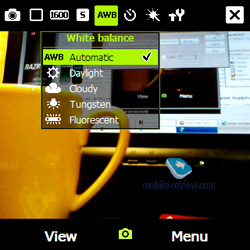
Effects:
- Black and White
- Sepia
- Green
- Aqua
- Negative
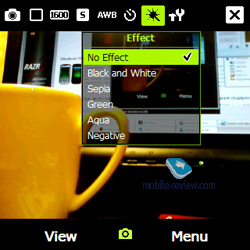
Also you can setup shutter speed, sounds for zooming in\out and brightness.
Apart from the still image and video modes, there are also timer and night modes available with the i780.
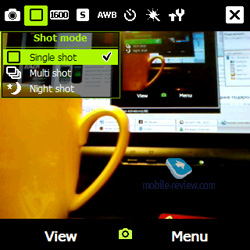
Snaps taken in natural light:
 |
 |
| (+) maximize, 1600õ1200, JPEG |
(+) maximize, 1600õ1200, JPEG |
 |
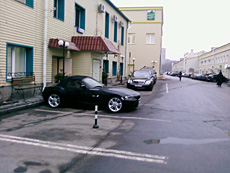 |
| (+) maximize, 1600õ1200, JPEG |
(+) maximize, 1600õ1200, JPEG |
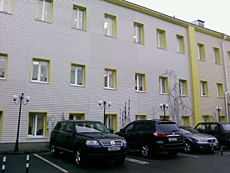 |
 |
| (+) maximize, 1600õ1200, JPEG |
(+) maximize, 1600õ1200, JPEG |
 |
 |
| (+) maximize, 1600õ1200, JPEG |
(+) maximize, 1600õ1200, JPEG |
 |
 |
| (+) maximize, 1600õ1200, JPEG |
(+) maximize, 1600õ1200, JPEG |
 |
 |
| (+) maximize, 1600õ1200, JPEG |
(+) maximize, 1600õ1200, JPEG |
 |
 |
| (+) maximize, 1600õ1200, JPEG |
(+) maximize, 1600õ1200, JPEG |
 |
 |
| (+) maximize, 1600õ1200, JPEG |
(+) maximize, 1600õ1200, JPEG |
 |
 |
| (+) maximize, 1600õ1200, JPEG |
(+) maximize, 1600õ1200, JPEG |
 |
 |
| (+) maximize, 1600õ1200, JPEG |
(+) maximize, 1600õ1200, JPEG |
 |
 |
| (+) maximize, 1600õ1200, JPEG |
(+) maximize, 1600õ1200, JPEG |
 |
 |
| (+) maximize, 1600õ1200, JPEG |
(+) maximize, 1600õ1200, JPEG |
 |
 |
| (+) maximize, 1600õ1200, JPEG |
(+) maximize, 1600õ1200, JPEG |
 |
 |
| (+) maximize, 1600õ1200, JPEG |
(+) maximize, 1600õ1200, JPEG |
 |
 |
| (+) maximize, 1600õ1200, JPEG |
(+) maximize, 1600õ1200, JPEG |
Snaps taken in artificial light:
Snaps taken indoors expose some noises, and generally come out even more blurry.
Night mode:
 |
 |
| (+) maximize, 1600õ1200, JPEG |
(+) maximize, 1600õ1200, JPEG |
 |
 |
| (+) maximize, 1600õ1200, JPEG |
(+) maximize, 1600õ1200, JPEG |
 |
 |
| (+) maximize, 1600õ1200, JPEG |
(+) maximize, 1600õ1200, JPEG |
 |
 |
| (+) maximize, 1600õ1200, JPEG |
(+) maximize, 1600õ1200, JPEG |
Effects:
 |
 |
| (+) maximize, 1600õ1200, JPEG |
(+) maximize, 1600õ1200, JPEG |
 |
 |
| (+) maximize, 1600õ1200, JPEG |
(+) maximize, 1600õ1200, JPEG |
 |
 |
| (+) maximize, 1600õ1200, JPEG |
(+) maximize, 1600õ1200, JPEG |
Digital zoom in action:
The camera can focus on a object 5-6 cm away from the lens.
No macro mode is available with the i780
Like the sample shots tell you right away, the image quality provided by the i780 is below par, as far as Samsung-branded handsets are concerned. On the other hand, there is absolutely no difference between the Samsung i780's 2 Mpix camera and the units embedded in Glofiish, Asus or Gigabyte models with fixed focus.
It takes the camera around 2-4 seconds to process the shot after you tap the shutter button, and then you have to wait at least 5 seconds before it will be able to take another pic.
All videos are recorded in 3GP (H.263 codec) in 320x240-pixel resolution (QVGA) or 176x144 (QCIF) with variable bitrate – 300-400 Kb/s. The settings for the video mode are the same as those for the stills.
Speaking of the unusual things about the camera, we can’t overlook the fact that it is impossible to disable the shutter sound, even if you turn all sounds off in the OS settings.
The video recording department of the i780 is a tad worse than the HTC TyTN II, HTC Touch Cruise, but still ahead most other communicators available.
All in all, our experience was slightly spoiled by, well, our expectations - we had wanted to see a Samsung-grade unit in the i780, while the company took on the cliche of the Windows Mobile market, so the imaging department is one of the weakest spots of the i780, given its prowess on other fronts.
Back to the table of contents >>>
Connectivity
The cellular module of the communicator taps into GSM (900/1800/1900) networks with EDGE as well as WCDMA 2100 with support for HSDPA. The i780 also comes installed with Bluetooth and WiFi modules.
The i780 employs a proprietary socket (USB 2.0) for data cable, charger and headsets. It also packs Wireless Manager for handling wireless connectivity options, as well as an extra menu on the Today screen (more on which later). Wireless Manager comes in with a pretty much straightforward and intuitive interface, which allows the user to enable and setup wireless connectivity options of the device.
Once you plug in a data cable in the i780, you can pick either of two modes: standard ActiveSync for data synch or Mass Storage, when the device's internal and external memory banks are identified as removable drives.
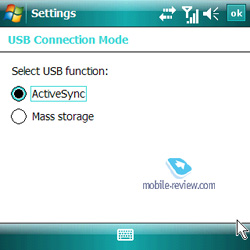
Bluetooth 2.0+EDR, the profile pool offered by the i780 is comparable with other communicators:
- Generic Access Profile (GAP). Provides the basis for all other profiles.
- Object Push Profile (OPP). A basic profile for sending "objects" such as pictures, virtual business cards, or appointment details.
- Hands-Free Profile (HFP). Connection of Bluetooth-headset and handsfree device.
- Headset Profile (HSP). The most commonly used profile, providing support for the popular Bluetooth Headsets to be used with mobile phones.
- Human Interface Device Profile (HID). Allows for a Bluetooth-keyboard.
- Advanced Audio Distribution Profile (A2DP). Sound transfer via Bluetooth.
- Audio Video Remote Control Profile (AVRCP). Music playback management via wireless headset.
- Personal Area Network Profile (PAN). Network connection via Bluetooth, use for connection of a desktop PC to Internet through the communicator, replaces Dual-Up Networking profile.
- SIM Access Profile (SAP). Allows connecting to a SIM card in a phone with Bluetooth, so the car phone itself doesn't require a separate SIM card.
- File Transfer Profile (FTP). Provides access to the file system on another device. This includes support for getting folder listings, changing to different folders, getting files, putting files and deleting files.
- Basic Printing Profile (BPP). Provides the user with the ability to print out photos over Bluetooth, without having to copy them to a PC.
The handset easily dealt with our wireless stereo-headsets; however the sound quality was pretty average, so it will only do if you are not a music buff.
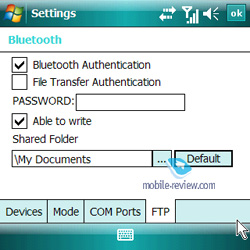
Wi-Fi 802.11b/g. We experience no hardships with the i780’s WiFi module. The communicator hooked up to our home hotspot hands down and never dropped the signal. It also handled the latest Skype version (2.2) in a convenient fashion both in chat and call modes. When we attempted to call with Skype over GPRS/EDGE, we had some delays of 5-6 seconds. What is really good about the i780 is that it almost doesn’t get warm during long WiFi sessions.
Back to the table of contents >>>
Hardware platform
The communicator runs the Qualcomm MSM 6260 platform and employs everything this chip can only offer. It also is responsible for the radio part, as well as navigation (similar to HTC’s solution – gpsOne). The OS of the i780 is powered by Marvell PXA3xx (the PXA310 according to unconfirmed reports). The CPU runs at 416 MHz, for video rendering the communicator also utilizes MMX, which was already available with the second generation of the platform (PXA27x).
Now let's see how the i780 fares in various performance tests we put all communicators though. Platform-wise, this is a milestone offering, being the first Windows Mobile communicator to make use of a new Marvell's platform gen - the PXA3xx.
Back to the table of contents >>>
Performance
Like we said, the Marvell PXA3xx's CPU runs at 416 MHz. And while the new platform doesn’t make all the difference as far as UI’s speed is concerned, you will surely notice and appreciate how fast Java runs and video is rendered even without running the i780 through a battery of tests.
Out of 128 Mb of RAM, the OS has access to around 108 Mb where roughly 31 Mb is always occupied by various services essential for the operating system, leaving you with 77 Mb for applications. But this is quite enough already – you will be able to run 15-25 applications at a time without having to worry about the i780 freezing up or slowing down.
The i780 comes equipped with 256 Mb of flash memory, where 146 Mb is user-manageable, but 50 Mb will be taken up by the applications the communicator installed on first start up (extra software from Samsung). The remnant memory volume is available for new apps, games and content.
We won’t be focusing on the way the i780 handles Java, since this functionality isn't what Windows Mobile is all about - most worthy Java-powered applications can be replaced by Windows Mobile counterparts. However, we have to note that the Samsung i780 is one of the first WM-based devices to support most Java profiles, including Java 3D. What is more, it is much speedier than most feature phones and smartphones, as far as Java functionality is concerned.
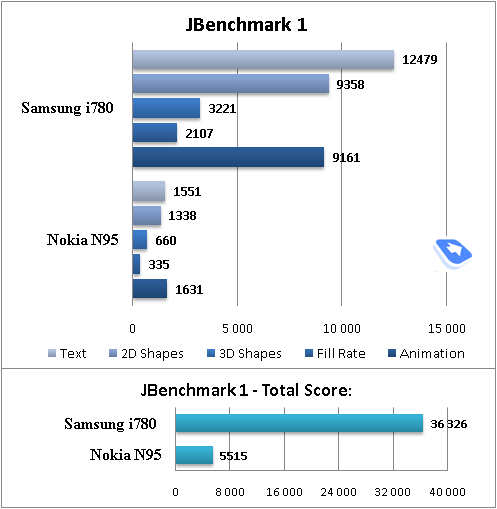
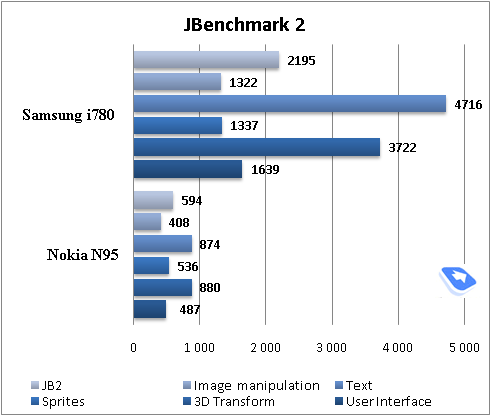
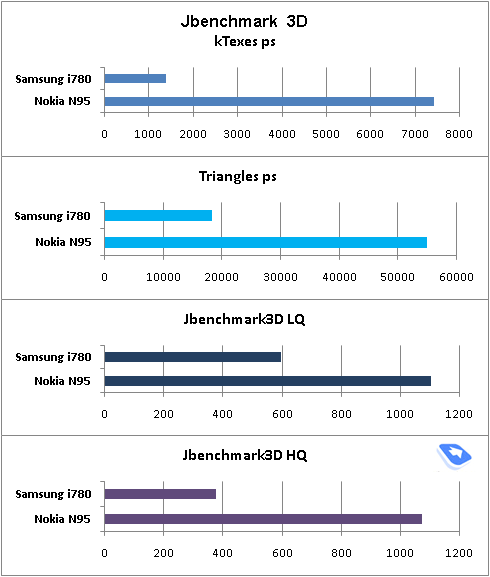
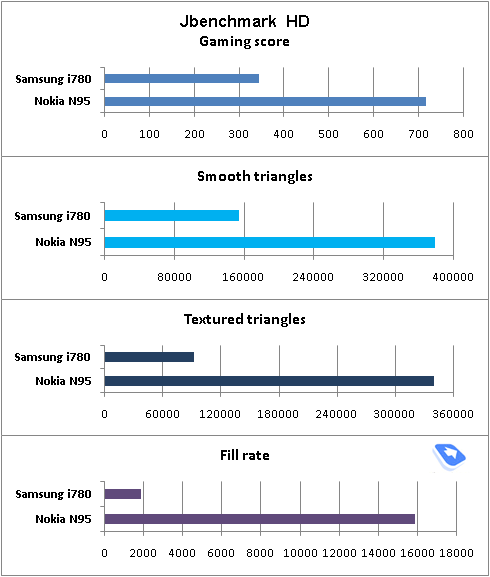
We ran the Samsung i780 through our standard battery of tests in the Core player and also faced it off against the best performance in the video rendering department – the i-mate Ultimate 8150 and the Gigabyte t600. All these devices run Marvell’s platforms, nevertheless, for i-mate and Gigabyte it is the second-gen solution, the PXA2xxx.
Let us remind you that the 100% performance indicates that all video clips in the given resolution and quality will be played back with no freeze ups, dropped frames (possible only in dynamic scenes). The rating of 120-130% means that the communicator in question is pretty much capable of perfect playback (no slowdowns or dropped frames at all) of video clips clips in the given resolution and quality.
In the first test all competitors employ only their CPUs – the solutions by i-mate and Samsung also utilize MMX.

The Samsung i780 is well ahead of the PXA2xx-based solutions – nothing to comment really, the device plays back non-converted DVD-grade videos hands down.
For the second test, we enabled the Gigabyte t600’s video accelerator to find out how well åðó 780 would fare against a 3D accelerator powered device.
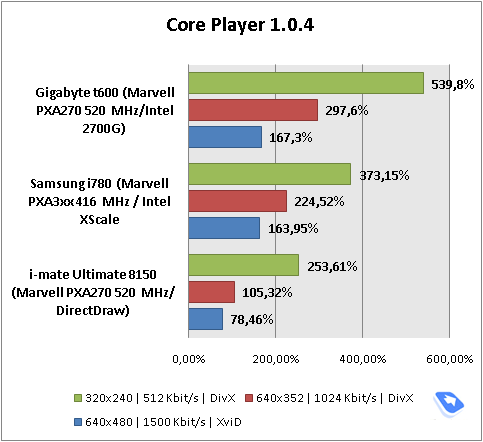
As you, nothing really changed – as far as high-quality videos are concerned, the Samsung i780 and the Gigabyte t600 are just a hair apart from each other.
The communicator’s computing power will be just sufficient for most tasks you can think of. Its vast RAM volume allows the user it run a slew of applications without worrying they might shutdown for the lack of free memory. But let us remind you that the OS itself can be the reason for slowdowns in menus, but those have nothing to do with the CPU speed, RAM volume or anything else. So in terms of menu navigation speed, the new CPU gives the i780 no considerable edge over other communicators.
Now a roundup for the Marvell PXA3xx platform. As far as new abilities and functionality are concerned, this solution brings nothing completely new for the Samsung i780, although, perhaps, the maker just hasn’t used the platform’s potential to its fullest. But what is for sure, the new platform by Marvell is a decent performer in the video department and generally a very fast solution, which can be well employed in games, emulators and non-converted movies.
Back to the table of contents >>>
Navigation(GPS)
The communicator makes use of the gpsOne chip, bundled in the Qualcomm MSM 6260 platform, supporting A-GPS technology (tracks your location through the carrier’s network). However, this chip doesn’t get along with third-party applications, as all GPS-enabled solutions, including the Samsung i780 are bound to deal with only one application – Navigon, also dubbed as Mobile Navigator in the Windows Mobile environment. While you can actually install some extra navigation software, rest assured, it won’t be able to employ the built-in chip, and thus, won’t track your location on the map.
We got our hands on the unit with disabled GPS, however Google Maps successfully identified the bundled GPS chip and tried to locate some satellites… for like 30 minutes, but sadly, to no avail.
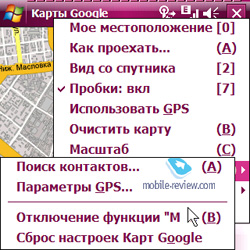
We will update this section as soon as we grab hold of a commercial unit.
Back to the table of contents >>>
Multimedia
The i780 comes packaged with a wired Samsung's headset, whose looks is definitely better than the sonic experience t delivers, which is pretty average, being in line with most other headsets on the market. The headset's wire houses a remote control for answering calls. The headphones themselves employ the earbud design, being quite small on top of that. There is a clothing clip available for the headset as well.
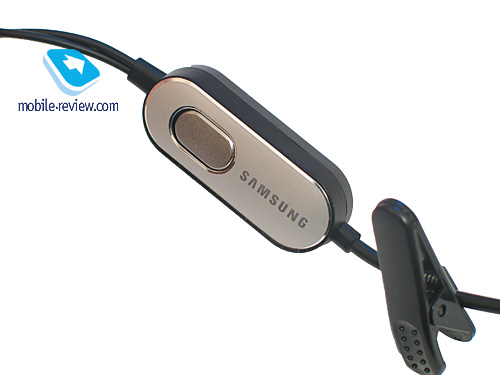
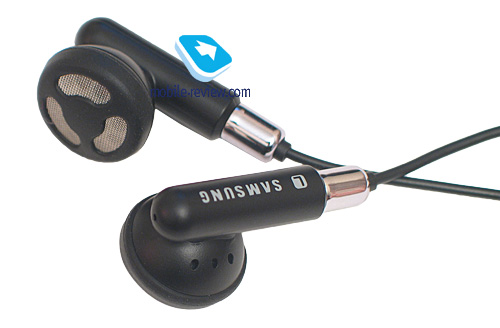
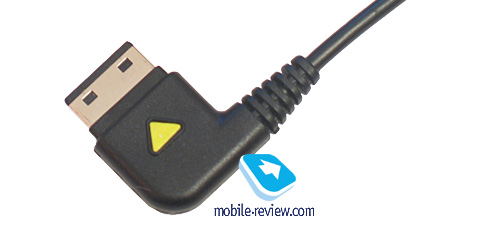
If you are intending to listen to your favorite tunes with the i780, then you better think about getting a 3,5 mm audio adapter beforehand, although, undemanding users won't have anything against using the default headset (with its flat, detail-less sound).
The device enjoys a standard Windows Media player for music, yet with a tiny plug-in built atop of it, which brings up a mini-player at the foot of the screen (used for jumping between tracks, pausing playback, adjust volume and getting back to the player’s default window)- it can be activated by flicking the key on the right-hand spine.
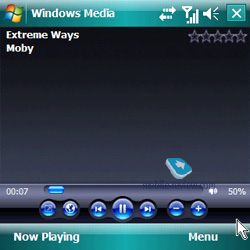
Back to the table of contents >>>
Software
You can learn more about the core functionality of Windows Mobile 6 Professional in our dedicated write-up, while here we will be focusing on the Samsung i780's extra software.
Samsung has need ranked the Windows Mobile market among its top priorities, and all the more surprising it is to see a bunch of new ideas, applications or even software shells coming packaged into every new WM-powered device. What is more, all software packs delivered by Samsung are very consistent - you will never find any useless utilities of software that looks like it was tacked on at the very last moment.
The Samsung i780 takes this concept one step further. The communicator comes only with a handful of full-fledged applications, yet brims with tiny details, making for a so much friendlier interface, as well as allowing you to forgo some seemingly standard applications you normally install outright.
First off, let’s see what utilities and system applications the i780 has in stock.
Today plus. The handset utilizes a proprietary home screen shell, slightly reminiscent of the famous SPB Pocket Plus and other applications. Although, with certain reservations - this utility occupies around a third of the real estate on the Today screen, it is also divided up into four tabs, each of them allows you access a certain pack of applications or settings.

The tabs themselves are relatively tiny, so you will need to practice a little, if you are going to handle them with fingers. And on the contrary, the icons of settings and applications housed under these tabs are quite sizable, and precision will never be an issue with them. You can't alter the default set of tabs, so these will always be: connections, favorites, contacts, setting.
Connections. This tab stores carrier name, dial, messaging, and wireless connectivity icons. While you can’t expand this pool, removing one of these items won't be a problem. Every time you get a call or a message, the corresponding icon inside this tab will get accompanied by “1” or any other number, depending on how many, say, unread messages you have in the box.
It may seem worthless at a glance, however it really comes in handy when you miss a call or a message – some just can't discern tiny system notifications for these events, and that's the point when the tab's sizable icons come to the rescue. You can also rearrange the items within the given tab.
Favorites. This one serves for storing the most vital and frequently used applications. You are also free to add any installed applications or even separate files, like a book or a text file into this tab.
Contacts. The tab allows storing up to 6 contact images and 3 photo-less entries. Contacts with assigned photos are placed on top, while those without sit at the bottom. Once you select an entry and tap it, the i780 will bring up a detailed view of the contact in question.
Setting. Click on this tab when you are looking for some settings or options – by default it holds a couple of memory indicators, hold button, but you can always add more items on the list.

Clock. One plug-in for the Today screen that replaces the default clock design – apart from current date (day/month/year) and weekday it also draws an analog or a digital clock on the display.
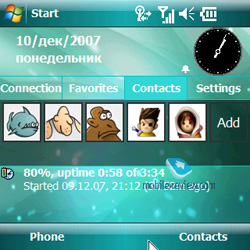
Under its belt are a couple of clock designs and a few color schemes.
Menu themes. You can pick one of the color schemes available in the OS settings (the wallpaper will change as well). It may not seem like much, but given that the standard OS themes have been around for years, we couldn’t be happier with this breath of fresh air.
Apart from this, there is also the Theme utility for playing around with the interface menu’s colors (no way to do that with the OS default functionality). Also this application enables you to change the wallpaper and font color.
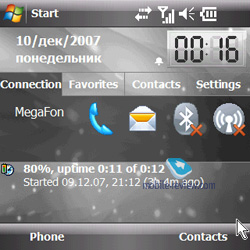
Wake Up Button. A tiny utility used for setting up how the i780 wakes up (display off mode) - whether it will spring into life only after you push the power button, or any key.
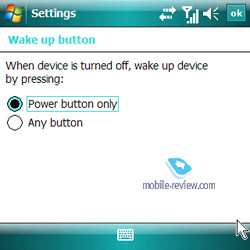
You are also at liberty to set the time (say, from 12 AM to 5 PM) when the keyboard’s backlighting will be inactive. On top of that, the i780 allows you adjust the backlighting timeout period.
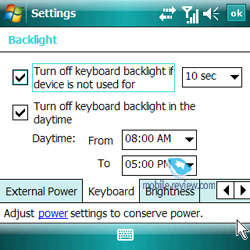
Java – this is an emulator for running Java-based applications. The Samsung i780 utilizes a proprietary app for handling Java applications, and what is more, the communicator supports most popular profiles, including Java 3D. But generally, its Java department feels quite shrunk because of the display resolution and lack of a conventional navigation button – specifically, you won’t be able to move around in games, since the touchpad is not enabled for Java processes.
Alarms – does the job as the default alarm clock found in the OS. Up to 9 alarms can be set up, the following options are available: alarm name, alarm activation, tune, repeat mode and cyclic triggering, if ignored.
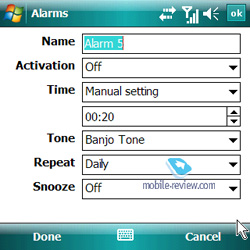
This menu also features the Wake-up Alarm. This is an alarm with manageable schedule and three fields for different triggering times, on top of that you can manually define when the alarm will trigger on specific days. The only available Alarm tone works for all triggers.
Contents Manager – a counterpart to the standard file explorer. Such features as various views (list or icons) , slideshow mode, file size, sorting by type (images, tunes, video) are enabled in the Contents Manager app. As for the drawbacks, the program recognizes only music, video and documents and doesn’t allow for handling other file types.
Podcast (S) – is an application for uploading podcasts and viewing multimedia (music and video) content of the communicator. Usually downloading a podcast via GPRS-connection takes quite a while, and this comes as no surprise, when you think how sizable most podcasts are. That’s why there is another way to go for uploading this type of content – PC synch or WiFi. All uploaded podcasts are displayed in a list and sorted by source. Also, there is a stand-alone menu with 10 most recent podcasts, as well as the library featuring all recently downloaded podcasts.

Podcasts are played back in the good old Windows Media Player.
Smart Converter – converts units, supposedly smart.
Picsel Viewer – this tool replaces the default Microsoft’s software pack for viewing documents and PDF-files. It isn't freely available from the menu, meaning that you won't be able to just start it up, but as soon as you click on any MS Office file or image, it will jump on the screen.
RSS Reader – a tool for reading news, RSS-channels and RSS-feeds. It is very easy to setup and a breeze to use. The app packs enough of punch to allow for easy checks of news feeds on the go. In every folder you can create an infinite number of RSS-channels. Should you have a set up news feed on PC you can import it to the application by selecting the OPML file you need or citing the link to this feed on the Web. For stand-alone channels you can set sorting type and view mode (with/without titles/description). Settings also include maximum number of uploaded news, manual or automatic updates.
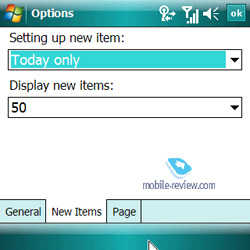
While viewing specific news feed the display is divided into two horizontal blocks. News headlines are placed on the top and at the bottom are the news item contents. When you tap the bottom of the display, you jump into the reading mode. Should you try to load a whole article the program will automatically throw the link into the web-browser.
Photo Slides – if you feel like viewing some pictures, then this is the right place to go. On its first launch, the application will scan the device’s memory and present you with a categorized selection of thumbnails for them. This utility really comes in handy when you need to show some photos to your friends. We particularly liked one of the modes available with the Photo Slides app – the one with a thumbnail bar at the foot of the screen, while the picture you are currently viewing is displayed full-screen.
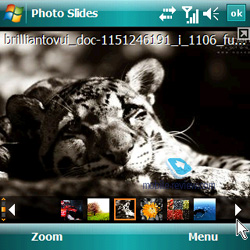
This application also allows for pretty basic image editing.
Task Manager – probably, the most unsophisticated and yet the most vital application, the one which this operating system could really use in its standard suite of applications. It can be launched either from the menu or by holding down the OK key. Once you do either of these things, the bottom of the screen will display the list with all currently running apps. To close the selected application tap the left soft-key and to terminate all launched apps just press the right soft-key. Incredibly simple, isn't it?
Our unit also came preinstalled with Opera for Windows Mobile, but it is still unclear whether this application will ship with commercial units as well. All up, we can only sigh over why Samsung is not focusing on the WM market and takes occasional shots at it with models like the i780.
While the suite of applications available with the i780 isn’t that big, every application retained by the communicator is top-notch, standing very close to their shareware counterparts. And what is more, they actually do get along with the communicator's design and concept very well.
Back to the table of contents >>>
Impressions
The reception quality was never an issue with the i780. The loudspeaker's volume was average or a tag higher than that, which made for audible calls in most environments. We found a couple of things to fault the vibro alert for – we couldn't feel it when the i780 was in outerwear or in a bag. The earpiece fared well in general with its pretty much average volume, however people on the other end of our calls would frequently complain about the phone's extremely sensitive microphone which rendered our voices excessively loud. But keep in mind that we didn’t have a commercial unit in our laboratory, so we believe when the i780 arrives this drawback will have already been dealt with.
The Samsung i780 has no direct rivals in sight – neither design-wise nor in terms of technological talents. And while its looks may be questioned by some (not all consumers are fond of thumbboards and thus thick casings, as well as square-shaped displays), as far as its spec sheet is concerned, the Samsung i780 packs more punch than any other device available today.
In this sense, the i780 is somewhat like the HTC TyTN II, however, the latter boasts a batter camera, yet a weaker CPU. Both retain displays with average resolutions, however the Samsung's matrix has the upper hand here. Here is a brief conclusion on what is good and what is bad about the i780:
The good:
- New platform, PXA3xx, packing the best-performing CPU among WM-powered solutions
- 128 Mb of RAM
- Decent display
- Robust build quality
- Well-picked suite of applications
The bad:
- Mediocre (for Samsung) 2 Mpix camera, which is only in line with other WM communicators
- Non-standard display resolution (320x320 pixels), bringing about issues with games and some applications
- Touchpad, installed instead of a conventional navigation key (not everyone finds it convenient)
And the most interesting. The device is slotted for early 2008 (in Russia), no word on exact release dates, though. But they have already let some info on its retail price slip – the i780 will go for 700 USD for both European and Russian (!) markets. We put an exclamation mark in there on purpose – there will actually be one price for these two markets. So even if you throw its letdowns into the equation, specifically a weakish camera, questionable ergonomics and a suqare display, all thanks to its price tag, the i780 morphs into one of the most intriguing offerings on the market of Windows Mobile communicators.
In essence, its price is almost half of what the HTC TyTN II goes for, lower than that of the HTC Touch Cruise, Glofiish X800, M800, X650, Asus P750 and even the Mio A702. What is more, while the Samsung i780 may not trump the above in some departments, it surely is on a par with them.
And now for the revelation we promised earlier in this write-up – why the i780 is very likely to be overlooked with all its merits and strengths. There are several reasons for that and the first one is that Samsung is not synonymous to Windows Mobile communicators in minds of most users. Many believe Samsung rolls out intuitive and eye-candy phones, which can be mastered by the very act of turning them on. Then, brand name. Which is all famous and renowned, yet has nothing to do with Windows Mobile. Essentially, the reverse thing is true as well – the consumers bent on Windows Mobile do remember that Samsung occasionally forays into this market with some solution, but they will hardly focus on devices from this maker alone. And that’s the place where another factor comes into play - the way the company treats the platform.
It is an open secret that most of Samsung's resources on the market of mobile devices are allocated to phones, whereas the segment of smartphones and communicators running Windows Mobile is more of a proving ground for the manufacturer. That's where the way it looks at this market stems from - as a rule, Samsung's solutions are loners on the Windows Mobile market, meaning that once they forge a new device, off it goes – no ad campaigns whatsoever, since the company doesn’t find the segment that interesting. But let's leave all these sad things behind. All we have left to say is that despite its oddball controls, quirky design and a very questionable square display, the Samsung i780 is still worth a glance or two.
Who will fall for this communicator? There is only one question to ask yourself to determine whether you are one of them or not – if you can live with all the abovementioned letdowns, then you should definitely keep the Samsung i780 towards the top of your short-list, as it is one of the best offerings on the WM market in terms of the price/quality ratio.
Related links:
Specifications:
- Type: Windows Mobile-communicator
- Form-factor: QWERTY-enabled candybar
- Rivals: no direct rivals
- Position in the line-up: first of a kind
- Materials used: plastic
- Operating system: Windows Mobile 6 Professional
- CPU: Marvell PXA3xx (416-624 MHz)
- RAM: 128 Mb (78 Mb for applications)
- ROM: 256 Mb (150 Mb available to user)
- Connectivity: microSD, Bluetooth 2.0+EDR (A2DP), Wi-Fi (IEEE802.11b/g/e), proprietary socket for charging/PC sync/headset
- GSM: 900/1800/1900, EDGE/GPRS; WCDMA 2100/HSDPA
- Display: 2.55”, 320x320-pixel resolution, 65K colors
- Camera: 2 Mpix, 320x240-pixel video recording
- Extras: GPS, touchpad, display tweaked for finger-based navigation
- Battery: detachable Li-Ion
- Dimensions: 116x62x15 mm
- Weight: 120 g
Back to the table of contents >>>
Artem Lutfullin (artem.lutfullin@mobile-review.com)
Translated by Oleg Kononosov (oleg.kononosov@mobile-review.com)
Published — 28 December 2007
Have something to add?! Write us... eldar@mobile-review.com
|
News:
[ 31-07 16:21 ]Sir Jony Ive: Apple Isn't In It For The Money
[ 31-07 13:34 ]Video: Nokia Designer Interviews
[ 31-07 13:10 ]RIM To Layoff 3,000 More Employees
[ 30-07 20:59 ]Video: iPhone 5 Housing Shown Off
[ 30-07 19:12 ]Android Fortunes Decline In U.S.
[ 25-07 16:18 ]Why Apple Is Suing Samsung?
[ 25-07 15:53 ]A Few Choice Quotes About Apple ... By Samsung
[ 23-07 20:25 ]Russian iOS Hacker Calls It A Day
[ 23-07 17:40 ]Video: It's Still Not Out, But Galaxy Note 10.1 Gets An Ad
[ 19-07 19:10 ]Another Loss For Nokia: $1 Billion Down In Q2
[ 19-07 17:22 ]British Judge Orders Apple To Run Ads Saying Samsung Did Not Copy Them
[ 19-07 16:57 ]iPhone 5 To Feature Nano-SIM Cards
[ 18-07 14:20 ]What The iPad Could Have Looked Like ...
[ 18-07 13:25 ]App Store Hack Is Still Going Strong Despite Apple's Best Efforts
[ 13-07 12:34 ]Infographic: The (Hypothetical) Sale Of RIM
[ 13-07 11:10 ]Video: iPhone Hacker Makes In-App Purchases Free
[ 12-07 19:50 ]iPhone 5 Images Leak Again
[ 12-07 17:51 ]Android Takes 50%+ Of U.S. And Europe
[ 11-07 16:02 ]Apple Involved In 60% Of Patent Suits
[ 11-07 13:14 ]Video: Kindle Fire Gets A Jelly Bean
Subscribe
|
